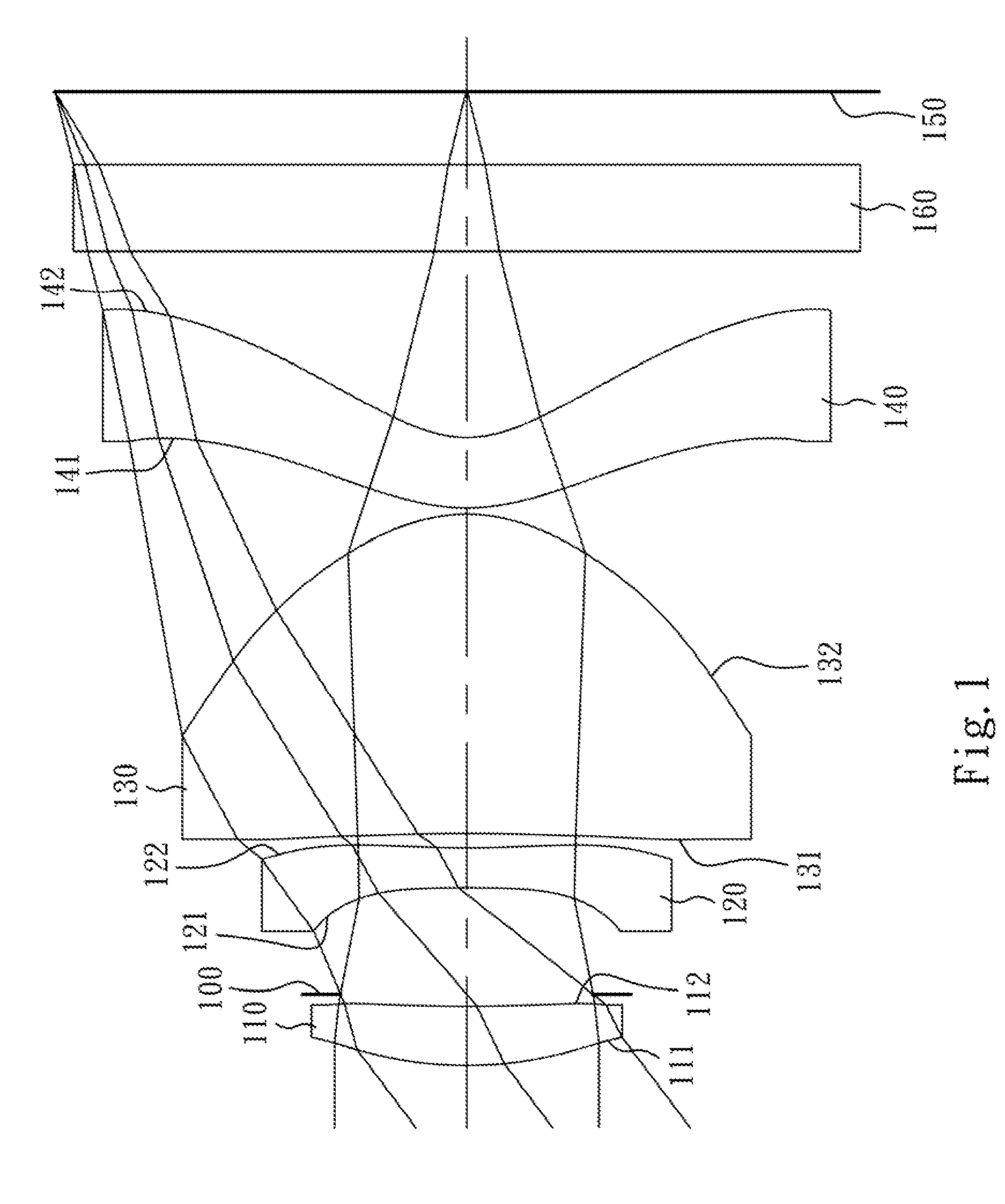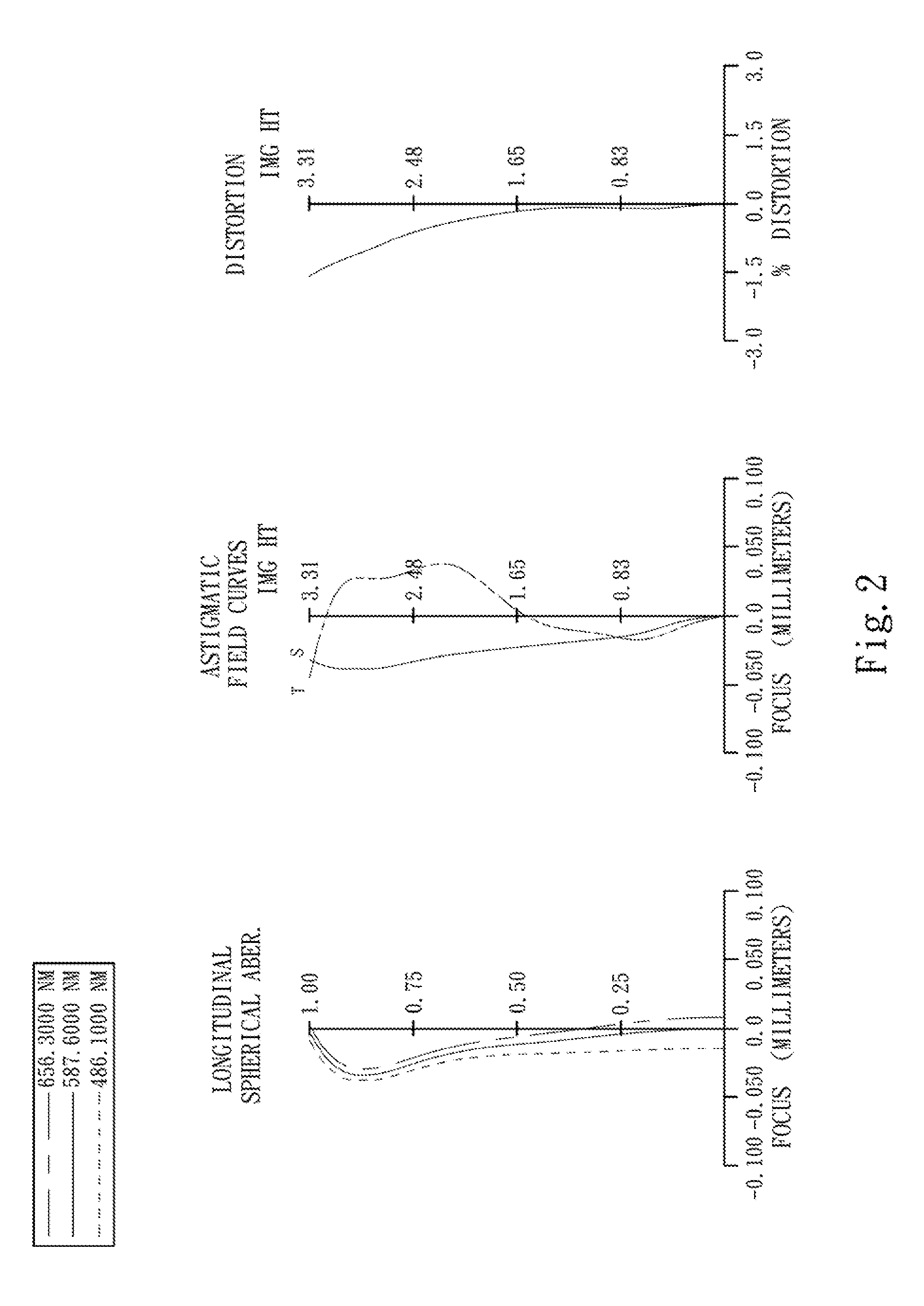Image capturing lens assembly
a technology of image capturing and lens assembly, which is applied in the direction of lenses, optics, instruments, etc., can solve the problems of inability to produce high-quality images, insufficient degree of freedom in setting system parameters, and the length of the total optical track of the lens structur
- Summary
- Abstract
- Description
- Claims
- Application Information
AI Technical Summary
Benefits of technology
Problems solved by technology
Method used
Image
Examples
first embodiment
[0070]The equation of the aspheric surface profiles of the aforementioned lens elements of the first embodiment is expressed as follows:
X(Y)=(Y2 / R) / (1+sqrt(1-(1+k)×(Y / R)2))+∑i(Ai)×(Yi)
[0071]where:
[0072]X is the height of a point on the aspheric surface spaced at a distance Y to from the optical axis relative to the tangential plane at the aspheric surface vertex;
[0073]Y is the distance from the point on the curve of the aspheric surface to the optical axis;
[0074]k is the conic coefficient; and
[0075]Ai is the i-th aspheric coefficient.
[0076]In the image capturing lens assembly according to the first embodiment, when f is a focal length of the image capturing lens assembly, Fno is an f-number of the image capturing lens assembly, and HFOV is half of the maximal field of view, these parameters have the following values:
[0077]f=4.47 mm;
[0078]Fno=2.10; and
[0079]HFOV=37.1 degrees.
[0080]In the image capturing lens assembly according to the first embodiment, when the Abbe number of the firs...
second embodiment
[0096]The detailed optical data of the second embodiment are shown in Table 3 and the aspheric surface data are shown in Table 4 below.
TABLE 32nd Embodimentf = 4.26 mm, Fno = 2.10, HFOV = 37.7 deg.SurfaceFocal#Curvature RadiusThicknessMaterialIndexAbbe #length0ObjectPlanoInfinity1Lens 14.162500(ASP)0.782Plastic1.53055.86.892−27.777800(ASP)0.0503Ape. StopPlano0.8494Lens 2−22.731600(ASP)0.300Plastic1.63423.8−7.0855.617800(ASP)0.1416Lens 3−19.921700(ASP)2.756Plastic1.54455.92.497−1.331240(ASP)0.0708Lens 41.786090(ASP)0.661Plastic1.65021.4−4.1190.914310(ASP)1.40010IR-filterPlano0.700Glass1.51764.2—11Plano0.25312ImagePlano—Note:Reference wavelength (d-line) is 587.6 nm.
TABLE 4Aspheric CoefficientsSurface #1245k =0.00000E+00−1.00000E+003.11080E+01−1.00000E+00A4 =−5.12391E−03−1.41991E−02−1.10414E−01−5.10673E−02A6 =−8.33553E−04−9.90083E−034.10304E−021.22074E−02A8 =−3.78405E−032.04421E−03−4.14555E−02−4.01018E−03A10 =1.27356E−03−1.92668E−031.49994E−025.16063E−04A12 =−5.43890E−043.66760E−04−3....
third embodiment
[0105]The detailed optical data of the third embodiment are shown in Table 5 and the aspheric surface data are shown in Table 6 below.
TABLE 53rd Embodimentf = 4.79 mm, Fno = 2.10, HFOV = 35.0 deg.SurfaceFocal#Curvature RadiusThicknessMaterialIndexAbbe #length0ObjectPlanoInfinity1Lens 13.946600(ASP)0.780Plastic1.53055.86.662−31.250000(ASP)0.0503Ape. StopPlano0.8214Lens 212.500000(ASP)0.393Plastic1.65021.4−8.4053.751200(ASP)0.1706Lens 3−23.792100(ASP)2.198Plastic1.54455.92.487−1.319880(ASP)0.0958Lens 43.062800(ASP)0.743Plastic1.54455.9−3.2791.030260(ASP)1.20010IR-filterPlano0.700Glass1.51764.2—11Plano0.46112ImagePlano—Note:Reference wavelength (d-line) is 587.6 nm
TABLE 6Aspheric CoefficientsSurface #1245k =−1.97270E−01−1.00000E+00−1.00000E+00−3.97482E+00A4 =−7.33388E−03−1.56104E−02−1.11832E−01−6.31839E−02A6 =−1.07196E−03−8.19252E−034.26939E−021.39280E−02A8 =−3.00491E−032.59569E−03−3.86726E−02−4.11234E−03A10 =1.17702E−03−2.04136E−031.52964E−023.21658E−04A12 =−5.43890E−043.66760E−04−3.4...
PUM
 Login to View More
Login to View More Abstract
Description
Claims
Application Information
 Login to View More
Login to View More - R&D
- Intellectual Property
- Life Sciences
- Materials
- Tech Scout
- Unparalleled Data Quality
- Higher Quality Content
- 60% Fewer Hallucinations
Browse by: Latest US Patents, China's latest patents, Technical Efficacy Thesaurus, Application Domain, Technology Topic, Popular Technical Reports.
© 2025 PatSnap. All rights reserved.Legal|Privacy policy|Modern Slavery Act Transparency Statement|Sitemap|About US| Contact US: help@patsnap.com



